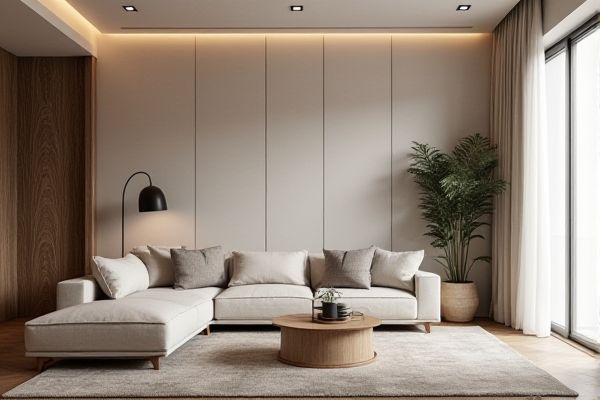
Minimalism emphasizes simplicity, functionality, and a clutter-free environment that promotes calmness and clarity. Maximalism embraces bold colors, diverse patterns, and abundant decor to create vibrant, expressive spaces; discover which style aligns best with Your personal taste in the rest of the article.
Table of Comparison
| Aspect | Minimalism | Maximalism |
|---|---|---|
| Design Philosophy | Less is more; simplicity and functionality | More is more; abundance and complexity |
| Color Palette | Neutral tones, limited colors | Vibrant, diverse, and bold colors |
| Decor Elements | Few, essential pieces | Multiple, eclectic items |
| Space Usage | Open, uncluttered areas | Filled, layered spaces |
| Focus | Functionality and clarity | Creativity and expression |
| Examples | Modern Scandinavian design, Japanese Zen interiors | Bohemian style, Baroque decor |
Understanding Minimalism and Maximalism
Minimalism emphasizes simplicity and functionality by using limited color palettes, clean lines, and uncluttered spaces to create a sense of calm and order. Maximalism embraces bold colors, eclectic patterns, and abundant decor, reflecting personal expression and creativity through complexity and layering. Understanding these design philosophies involves recognizing minimalism's focus on essentials and minimal distractions versus maximalism's celebration of variety and vibrancy in interior aesthetics.
Historical Origins of Both Styles
Minimalism emerged in the 1960s as a reaction against the excesses of Abstract Expressionism, emphasizing simplicity, clean lines, and monochromatic palettes inspired by artists like Donald Judd and Frank Stella. Maximalism has roots in the Baroque and Rococo periods of the 17th and 18th centuries, characterized by ornate details, rich colors, and layered textures reflecting a philosophy of abundance and complexity. Both styles represent contrasting aesthetic philosophies, with minimalism focusing on restraint and functionality, while maximalism embraces extravagance and eclectic visual richness.
Core Principles of Minimalism
Minimalism emphasizes simplicity, functionality, and intentionality by removing excess and focusing on essential elements that promote clarity and calm. It prioritizes quality over quantity, clean lines, neutral color palettes, and uncluttered spaces to create an environment of tranquility and purpose. This design philosophy encourages mindful consumption and the elimination of distractions to enhance both aesthetic appeal and mental well-being.
Key Characteristics of Maximalism
Maximalism is characterized by bold colors, intricate patterns, and a mix of textures that create visually rich and dynamic spaces. It embraces layering of diverse elements, such as eclectic furniture, vibrant artwork, and an abundance of decorative accessories, to convey personality and abundance. This design style often incorporates maximal contrast and a fearless use of statement pieces that draw attention and spark conversation.
Aesthetic Appeal: Less or More?
Minimalism emphasizes clean lines, open spaces, and a restrained color palette, creating a calming and uncluttered aesthetic appeal. Maximalism, with its bold colors, diverse patterns, and layered textures, offers a vibrant and dynamic visual experience that celebrates abundance and personal expression. Your choice between less or more depends on whether you prefer simplicity and tranquility or richness and complexity in design.
Functionality in Minimalist vs Maximalist Spaces
Minimalist spaces prioritize functionality by emphasizing clean lines, open areas, and essential furnishings that reduce distractions and promote efficiency. Maximalist environments, while visually abundant, require thoughtful organization of decor and furniture to maintain usability without overwhelming the space. Your choice between these styles impacts how functional and comfortable your environment feels daily.
Psychological Impact of Minimalism and Maximalism
Minimalism fosters a sense of calm and clarity by reducing visual clutter, which can decrease stress and improve focus. Maximalism, with its rich colors and abundant patterns, stimulates creativity and emotional expression, offering a dynamic and energizing environment. Psychological studies indicate that minimalist spaces promote mindfulness and relaxation, while maximalist designs encourage social interaction and cognitive engagement.
Sustainability Considerations
Minimalism promotes sustainability by reducing consumption and waste, encouraging You to prioritize quality over quantity for a smaller ecological footprint. Maximalism, while often seen as excessive, can support sustainability when emphasizing upcycling, reuse, and the ethical sourcing of diverse materials. Choosing between these styles impacts Your environmental responsibility, with minimalism typically offering clearer pathways to eco-friendly living.
Popular Examples in Interior Design
Minimalism in interior design is exemplified by Scandinavian style, featuring clean lines, neutral color palettes, and functional furniture, as seen in spaces designed by companies like Muuto or IKEA. Maximalism is embodied by the eclectic interiors of artists like Kelly Wearstler, characterized by bold colors, diverse textures, and layered patterns that create visually rich environments. Both styles leverage contrasting design philosophies to achieve unique aesthetics, with minimalism emphasizing simplicity and maximalism embracing abundance.
Choosing the Right Approach for Your Lifestyle
Minimalism emphasizes simplicity, prioritizing essential items to create a clutter-free and peaceful environment, ideal for those seeking calm and focus. Maximalism embraces bold colors, patterns, and eclectic decor, reflecting a vibrant, expressive personality suited to individuals who thrive in dynamic, visually stimulating spaces. Your choice depends on whether you value tranquility and space efficiency or creativity and personalization in your daily life.
 homyna.com
homyna.com